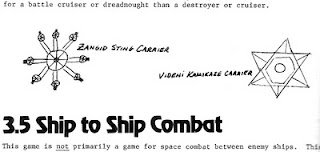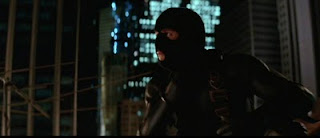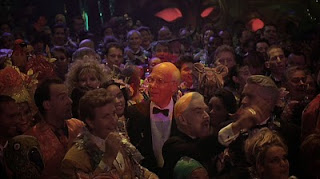
 Part of me feels as if I should really be covering Batman: The Dark Knight Returns. But I foolishly sold off my first editions of that comic years ago, so all I have is the square-bound trade paperback, and it's really hard to scan. So I'm going to put that off a while longer and talk about another Frank Miller joint, Hard Boiled.
Part of me feels as if I should really be covering Batman: The Dark Knight Returns. But I foolishly sold off my first editions of that comic years ago, so all I have is the square-bound trade paperback, and it's really hard to scan. So I'm going to put that off a while longer and talk about another Frank Miller joint, Hard Boiled.By the late 80's, Frank Miller could do anything he wanted in comics. His run on Daredevil had made it one of Marvel's best-selling and most-imitated comics, and his Wolverine mini-series with Chris Claremont had been a huge success. His Ronin mini-series had wandered a bit, but was solid and exciting. His Batman: The Dark Knight Returns had not only redefined the character for an entire generation of fans, but also (along with Alan Moore's work on Swamp Thing) changed literally the entire business of comics in America.
Frank Miller was the man. Everything he did was golden. There could never be enough Frank.
Or so he must have thought in 1986 when he decided to stop drawing comics and concentrate solely on writing them for other artists. It was a mistake.
It started out well enough. His Daredevil graphic novel, Love and War, was a quality piece of work with brilliant, quirky art by Bill Sienkeiwicz. And the Batman: Year One storyline with art by David Mazzuchelli was an excellent companion piece to his previous graphic novel, providing plenty of material for future filmmakers to
But then things took a wrong turn. One problem was that Miller had never really been that great a writer; he did some action tropes very well, and he was good at finding an interesting angle on a character. His work was a level above some of the old guard of the 70's, the Roy Thomases and Elliot S! Magginses and Bill Mantlos. But it lacked the subtlety of the best of his peers.
What had made his previous comics great was that he had also drawn them. Which is not to say he was a great artist, either. His figures were clunky, and his work lacked grace and detail. But what Miller did in the early to mid-80's, better than any other comics artist of his day, was to take the influences of manga and movies and translate them to the page for a visceral impact that no one else could match. While most everybody else was busy imitating Kirby's abstract bombast or Neal Adams's sketchy realism, Frank Miller was drawing movie storyboards that were blowing the older styles out of the water.
Miller's work was daring and fresh. Sometimes he would skillfully layer in dialogue and captions as a counterpoint to the action. Sometimes he would just forego words altogether and spend pages in silent action, which was such a relief after years of Spidey's lame wisecracks. There were better artists and better writers, but there were damn few other comics that competed with Miller's as a complete package. So it was really ironic that when Miller teamed up with better artists, the quality of the overall work went downhill.
Another part of the problem was that around 1989 or so, Miller somehow decided he wanted to write comedy. It seems to have started with the "Robocop 2" screenplay that he wrote (later rewritten by Walon Green). The problem is that Miller's just not funny. His sense of humor (at least judging from his comics) is very black and satirical, and it just doesn't come across very well. You can watch "Robocop 2" or read Hard Boiled and recognize that, "yes, this was meant to be funny, I see that," but it's never executed well enough to actually make you, you know, laugh.
Which leads me (finally) to Hard Boiled, written by Miller and drawn by Geof Darrow, first published in 1990 by Dark Horse Comics. The story: A psychotic android named Nixon (at least, that's what he sometimes thinks his name is--his owners, Willeford Home Appliances, just call him Unit Four) goes on a rampage, killing hundreds of people. The Willeford corporation whisks him back to headquarters, fixes him up, and sends him to his home in the suburbs as Harry Seltz (or maybe Burns), all fixed up. Until the next day, when everything blows up again and Nixon-Seltz-Burns-Four learns that he may be fated to save all androidkind. After killing a very large percentage of humankind.
Or something.
It's a little hard to follow, just because the entire story is so hallunicatory. Not only can Nixon not keep his identity straight, but the entire world has this ugly, dreamlike weirdness that keeps the plot from ever actually registering in the brain.
Guards with pistols strapped to every available inch of their bodies. A hugely fat blob of a man who lounges like Baron Harkonnen in a huge vat while his body is scrubbed and massaged by a legion of nude robot fairies. Talking dogs who shoot lasers out of their eyes. Nixon's creepy children, who cuss like adults and watch their dad-bot having sex with their mom, and may be robots themselves. Enormous public orgies and a supermarket full of oddly oversized products. And of course, surgical equipment powered by candy bars and fetuses.

(I'm sorry for the blurry scans, but I'm too lazy to redo them) If you look closely at the surgical robot apparatus here, you can see some resemblance to Darrow's later work on the Matrix movies. Like his later work on The Big Guy and Rusty, the Boy Robot, Darrow's obsessive attention to detail is both a plus and a minus. On the positive side, his work is unique and arresting, and a lot of the tiny details are truly funny and creative. On the other hand, the wealth of detail can cause pages to blur into a mush of tiny precise scribbles, like this double-page spread of Nixon facing off against a car armed with some wicked miniguns (click the images for larger versions--I normally scale the pics way down, but with Darrow's work, I've left them pretty big so you can appreciate the level of detail).

The level of detail is amazing, but it's so busy that it lacks dramatic impact. And it's not helped by Claude Legris's airbrushed colors, which just make everything even more muddy and indistinct.
Oh, and speaking of double-page spreads, one other really unusual thing about Hard Boiled is just how much it relies on full-page and double-page splash pages. Fully half the first issue is made up of full-page and double-page images, and the other issues feature almost as much. Sometimes it works really well, such as this dramatic moment when we see just how much damage Nixon has taken from his latest mishap (a devastating head-on collision).
Yes, the page is still full of detail, with some nicely goofy touches like the car keys embedded in Nixon's head. But the detail doesn't detract from the composition, unlike the spread above.
It's hard to tell how much of the goofiness is Miller's and how much is just a matter of Darrow going wild. But some parts, like the talking dogs and the creepy kids (echoing the creepy drug dealer kid from "Robocop 2"), are definitely Miller's doing. And then there's this:
What's funny about this is that it's Miller parodying his own work, having his nutball character narrate himself in terse first-person present just like Batman's inner dialogue in Batman: The Dark Knight Returns, only Nixon's actually speaking out loud. What's funnier is that Miller then went back to playing it straight in Sin City. What's not so funny is that Miller tried to go back to the self-parody well again in "The Spirit," having Denny Colt narrate himself to different characters (and a cat). It didn't work any better there than it does here.
 And of course, there was the final indignity, which was that the first and second issues were published in September and December of 1990, after which we had to wait over a year for the third and final issue in March 1992 (American/Canadian exchange rates apparently changed drastically in the intervening time - the U.S. prices for issues 2 and 3 are the same, but the Canadian price for issue 3 was two dollars higher than issue 2). It helped that the (incredibly gory) cover did apologize for the delay, but not much. Especially given the weirdly anti-climactic and depressing ending. The whole thing just felt like a misfire from start to finish. A competently written, very well-drawn misfire, but still...
And of course, there was the final indignity, which was that the first and second issues were published in September and December of 1990, after which we had to wait over a year for the third and final issue in March 1992 (American/Canadian exchange rates apparently changed drastically in the intervening time - the U.S. prices for issues 2 and 3 are the same, but the Canadian price for issue 3 was two dollars higher than issue 2). It helped that the (incredibly gory) cover did apologize for the delay, but not much. Especially given the weirdly anti-climactic and depressing ending. The whole thing just felt like a misfire from start to finish. A competently written, very well-drawn misfire, but still...
 And of course, there was the final indignity, which was that the first and second issues were published in September and December of 1990, after which we had to wait over a year for the third and final issue in March 1992 (American/Canadian exchange rates apparently changed drastically in the intervening time - the U.S. prices for issues 2 and 3 are the same, but the Canadian price for issue 3 was two dollars higher than issue 2). It helped that the (incredibly gory) cover did apologize for the delay, but not much. Especially given the weirdly anti-climactic and depressing ending. The whole thing just felt like a misfire from start to finish. A competently written, very well-drawn misfire, but still...
And of course, there was the final indignity, which was that the first and second issues were published in September and December of 1990, after which we had to wait over a year for the third and final issue in March 1992 (American/Canadian exchange rates apparently changed drastically in the intervening time - the U.S. prices for issues 2 and 3 are the same, but the Canadian price for issue 3 was two dollars higher than issue 2). It helped that the (incredibly gory) cover did apologize for the delay, but not much. Especially given the weirdly anti-climactic and depressing ending. The whole thing just felt like a misfire from start to finish. A competently written, very well-drawn misfire, but still...



























































